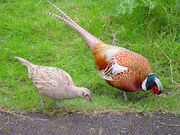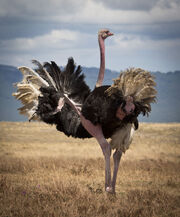No edit summary |
|||
| (4 intermediate revisions by 4 users not shown) | |||
| Line 22: | Line 22: | ||
| − | Hedrick, A.V & Temeles, E.J.(1989). The evolution of sexual dimorphism in animals: hypotheses and tests. TREE, 4(5): 136-138. |
+ | Hedrick, A.V & Temeles, E.J.(1989). The evolution of sexual dimorphism in animals: hypotheses and tests. TREE, 4(5): 136-138.[[File:Ostrich.jpg|thumb|Ostrich are an example of sexual dimorphism. Males have contrasting black and white feathers, while females remain all greyish brown.]] |
| + | ==Zebra Finch Example== |
||
| + | An interesting study was done using zebra finches to determine if females would prefer male zebra finches with brighter, more colorful beaks. Two groups of males were separated and fed a different diet, those males who received carrots in their diet developed stronger, more vibrant coloration in their beaks. When females were given the opportunity to chose between males with dull beaks or brightly colored beaks, they chose those with brightly colored beaks 9 times out of 10. For some reason the video section on this page isn't working, so I will post the video here: http://www.bbc.co.uk/programmes/p00f462y |
||
| + | |||
| + | Scientists believe females chose males with brightly colored beaks (or red pigment in beaks) because they are more attractive to the females, as well as males with red pigments have a diet that is able to help them fight diseases better, which would allow females to select these males based on the idea that they will pass along disease-fighting genes to their offspring (BBC, http://www.bbc.co.uk/programmes/p00f462y) |
||
| + | |||
| + | |||
| + | [[File:Greater Bird-of-paradise|thumb|right|335 px|Sexual Dimorphism in the Greater Bird of Paradise]] |
||
| + | ==Sexual Dimorphism in the Greater Bird of Paradise== |
||
| + | [[Category:Sexual Dimorphism]] |
||
Latest revision as of 02:22, 2 December 2013

Sexual Dimorphism is the difference in form between males and females of the same species.
Definition
Sexual dimprphism is an observable difference in appearance between males and females in the same species. These differences can include variations in color, shape, structure and size. Sometimes the differences are extreme for example the male birds of paradise which exhibit large plumes of feathers with exotic colors. Another example would be a male lion with its large mane, and the female without.
Three Major Hypotheses Leading to Sexual Dimorphism
Each of these hypotheses can operate in natural populations, and are therfore considered plausible:
- Sexual Selection
- In species with larger males,it is observed that the males physcially compete with each other for a mate.
- Female preference for certain male size and morphologies.
2. Dimorphic Niche Hypothesis
- Most studies are focused on selection pressures which act only on females.
- In species with females which are larger than males,the size correlation can be attributed to the need for females to produce and carry young.
- It issuggested that the larger the female, the more offspring, they can produce. Lifetime fecundity overall is also increased.
3. Food Competition Between Sexes
- Sexual dimporphism is maintained during nonbreeding season based on food competition between sexes.
- Rates of energy intake among pairs shouldbe correlated based on territory quality, breeding timing and predation. This should also be compared with reproductive success.
Hedrick, A.V & Temeles, E.J.(1989). The evolution of sexual dimorphism in animals: hypotheses and tests. TREE, 4(5): 136-138.

Ostrich are an example of sexual dimorphism. Males have contrasting black and white feathers, while females remain all greyish brown.
Zebra Finch Example
An interesting study was done using zebra finches to determine if females would prefer male zebra finches with brighter, more colorful beaks. Two groups of males were separated and fed a different diet, those males who received carrots in their diet developed stronger, more vibrant coloration in their beaks. When females were given the opportunity to chose between males with dull beaks or brightly colored beaks, they chose those with brightly colored beaks 9 times out of 10. For some reason the video section on this page isn't working, so I will post the video here: http://www.bbc.co.uk/programmes/p00f462y
Scientists believe females chose males with brightly colored beaks (or red pigment in beaks) because they are more attractive to the females, as well as males with red pigments have a diet that is able to help them fight diseases better, which would allow females to select these males based on the idea that they will pass along disease-fighting genes to their offspring (BBC, http://www.bbc.co.uk/programmes/p00f462y)

Greater Bird-of-paradise
Sexual Dimorphism in the Greater Bird of Paradise